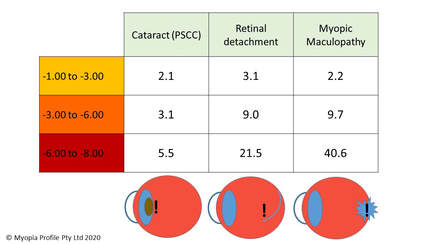|
Myopia or nearsighted is an epidemic. 50% of world population will be myopic by 2050 and one billion of those people will be over -6.00, considered high myopia.
High myopia will lead to increased risk of serious ocular health issues: 14.4x increase in glaucoma, 7.8x increase in retinal pathology, etc. |
Myopia control or management are developed methods to help slow down or halt the progression of myopia.
Managing myopia starts with being aware of your child's visual environment. Managing indoor electronic time and outdoor play time can help a child from becoming myopic and reduce the risk of fast progression.
Outdoor time is important:
Spend at least 90 minutes a day outdoors
Don’t forget sun protection – hats, sunglasses and shade
Be physically active for least 60 minutes a day
Indoor time
Take regular breaks from reading – the 20/20 rule
Don’t hold reading material or screens too close – the elbow rule; if possible watch videos on TV
Try to limit leisure screen time to two hours per day in school aged children.
Once a child is near sighted your child's eyecare provider should discuss options to prescribe a special type of contact lenses to help slow down or halt myopia.
Managing myopia starts with being aware of your child's visual environment. Managing indoor electronic time and outdoor play time can help a child from becoming myopic and reduce the risk of fast progression.
Outdoor time is important:
Spend at least 90 minutes a day outdoors
Don’t forget sun protection – hats, sunglasses and shade
Be physically active for least 60 minutes a day
Indoor time
Take regular breaks from reading – the 20/20 rule
Don’t hold reading material or screens too close – the elbow rule; if possible watch videos on TV
Try to limit leisure screen time to two hours per day in school aged children.
Once a child is near sighted your child's eyecare provider should discuss options to prescribe a special type of contact lenses to help slow down or halt myopia.

